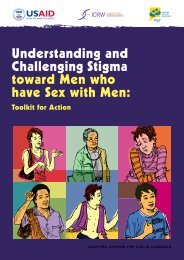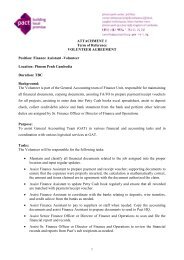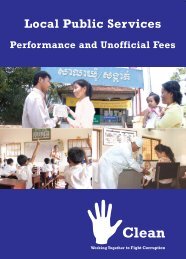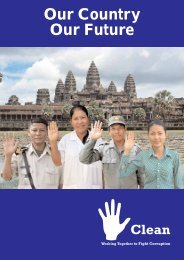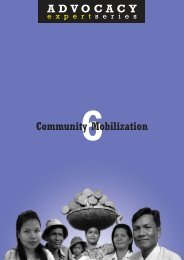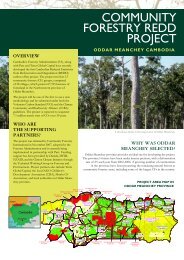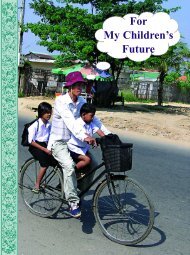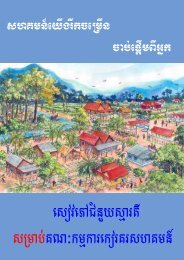Advocacy in Cambodia: Increasing Democratic ... - Pact Cambodia
Advocacy in Cambodia: Increasing Democratic ... - Pact Cambodia
Advocacy in Cambodia: Increasing Democratic ... - Pact Cambodia
You also want an ePaper? Increase the reach of your titles
YUMPU automatically turns print PDFs into web optimized ePapers that Google loves.
dissem<strong>in</strong>at<strong>in</strong>g <strong>in</strong>formation • rais<strong>in</strong>g awareness and concern • network<strong>in</strong>g<br />
advocacy<br />
strategies<br />
stag<strong>in</strong>g organized action • facilitat<strong>in</strong>g engagement • lobby<strong>in</strong>g<br />
Increas<strong>in</strong>g <strong>Democratic</strong> Space<br />
While most successful advocacy campaigns<br />
vary considerably <strong>in</strong> their design, the <strong>Advocacy</strong><br />
Institute suggests that a common characteristic<br />
of successful campaigns is the use of a wide range<br />
of strategies and techniques. <strong>Advocacy</strong> campaigns<br />
conducted <strong>in</strong> <strong>Cambodia</strong> have employed a variety<br />
of strategies, the most common of which can be<br />
classified <strong>in</strong>to six broad categories:<br />
• dissem<strong>in</strong>at<strong>in</strong>g <strong>in</strong>formation;<br />
• rais<strong>in</strong>g awareness and concern;<br />
• stag<strong>in</strong>g organized action;<br />
• facilitat<strong>in</strong>g engagement;<br />
• lobby<strong>in</strong>g; and<br />
• network<strong>in</strong>g.<br />
Dissem<strong>in</strong>at<strong>in</strong>g Information<br />
Perhaps one of the most powerful advocacy<br />
strategies used by NGOs is the collection and<br />
dissem<strong>in</strong>ation of <strong>in</strong>formation. Information can be<br />
used to legitimize advocacy issues and <strong>in</strong>form<br />
decision-makers, provid<strong>in</strong>g them with arguments<br />
for why a reform is necessary. There are two<br />
aspects to <strong>in</strong>formation strategies: collect<strong>in</strong>g<br />
<strong>in</strong>formation on problems and collect<strong>in</strong>g<br />
<strong>in</strong>formation on prevail<strong>in</strong>g public op<strong>in</strong>ion.<br />
Document<strong>in</strong>g Problems<br />
Perhaps the best example of <strong>in</strong>formation that<br />
helped <strong>in</strong>itiate an advocacy campaign is research<br />
that was conducted by the Project Aga<strong>in</strong>st<br />
Domestic Violence (PADV). In 1994, a group of<br />
concerned women surveyed 50 victims of<br />
domestic violence. The follow<strong>in</strong>g year PADV<br />
produced a Household Survey on Domestic<br />
Violence <strong>in</strong> <strong>Cambodia</strong> <strong>in</strong> cooperation with the<br />
M<strong>in</strong>istry of Women’s Affairs. Thanks to this and<br />
other studies, today domestic violence is openly<br />
acknowledged as a problem <strong>in</strong> <strong>Cambodia</strong>. The<br />
<strong>in</strong>clusion of questions on domestic violence <strong>in</strong> the<br />
M<strong>in</strong>istry of Plann<strong>in</strong>g’s Demographic and Health<br />
Survey is an <strong>in</strong>dication that the problem is no<br />
longer be<strong>in</strong>g concealed. The presentation of<br />
statistics and personal stories are an important<br />
strategy for generat<strong>in</strong>g support from the public<br />
and government officials.<br />
Oxfam GB’s Land Study Project is another<br />
example of a research project that has forced<br />
policy makers and development actors to<br />
acknowledge that land disputes are a major issue<br />
<strong>in</strong> <strong>Cambodia</strong> which need to be addressed. On a<br />
smaller scale, the NGO Forum’s Fisheries Work<strong>in</strong>g<br />
Group produced a series of case studies to<br />
document <strong>in</strong>cidences of fisheries violations. The<br />
case studies gave the first documented description<br />
of the escalation of disputes and provided specific<br />
<strong>in</strong>formation on which articles of the law were<br />
be<strong>in</strong>g violated. These legal details provide<br />
advocates with important justification when<br />
address<strong>in</strong>g authorities. One of the lessons learned<br />
early on <strong>in</strong> the preparation of these documents was<br />
the need to distribute them <strong>in</strong> Khmer to<br />
government workers and other <strong>in</strong>terested actors.<br />
In other examples, human rights groups<br />
conduct <strong>in</strong>vestigations and regularly dissem<strong>in</strong>ate<br />
their f<strong>in</strong>d<strong>in</strong>gs to the Department of Justice, police<br />
department, and UNCHR. The Kompong Cham<br />
advocacy KANAN network provides reports to the<br />
NGO Forum, Wetlands International, and Oxfam<br />
GB regard<strong>in</strong>g natural resources and the<br />
environment.<br />
While NGOs are mak<strong>in</strong>g an effort to collect<br />
important <strong>in</strong>formation, it is often difficult for<br />
<strong>in</strong>terested actors to access that <strong>in</strong>formation. For<br />
example, the researchers of this report were hard<br />
pressed to locate statistics on urban poverty,<br />
fish<strong>in</strong>g violations, or the frequency and<br />
effectiveness of strikes. Even a formal network<br />
such as the HIV/AIDS Coord<strong>in</strong>at<strong>in</strong>g Committee<br />
does not have ready <strong>in</strong>formation on the number<br />
of HIV positive people, and has no <strong>in</strong>formation<br />
that can be distributed through electronic media.<br />
Strong advocacy campaigns will <strong>in</strong>variably<br />
ma<strong>in</strong>ta<strong>in</strong> current materials on their sector to<br />
distribute to <strong>in</strong>terested actors <strong>in</strong> order to legitimize<br />
their campaigns among stakeholders.<br />
Assess<strong>in</strong>g Public Op<strong>in</strong>ion<br />
Another strategy <strong>in</strong>volv<strong>in</strong>g <strong>in</strong>formation is the<br />
24




